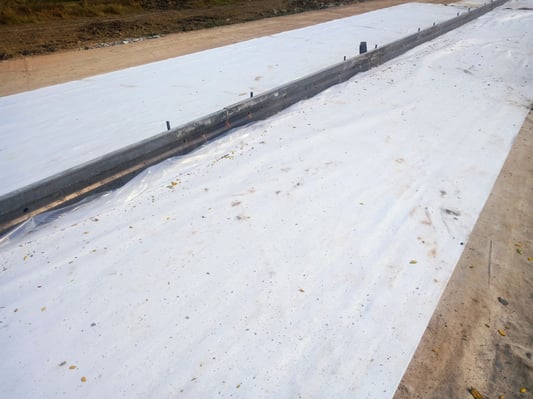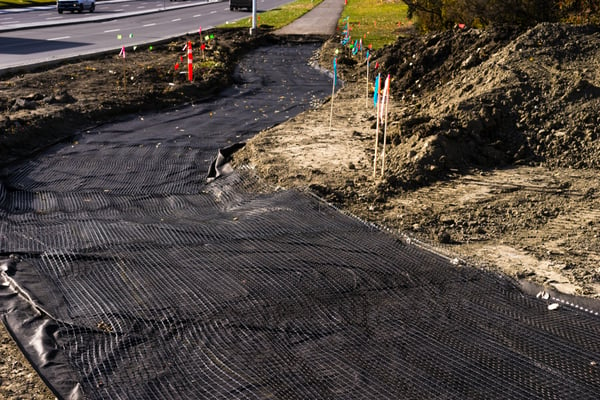Geotextiles in Construction

Geotextiles are synthetic and permeable materials used in civil construction projects to improve soil characteristics. Geotextiles make poor soils more suitable for construction since they have the ability to separate, filter, reinforce, protect, and drain soils.
Geotextiles are useful in many infrastructure works such as roads, landfills, harbors, drainage structures, and other civil engineering projects.
Types of Geotextiles
Geotextiles are made from polymers such as polypropylene and polyester. They are divided into three categories, according to their manufacturing process::
- Woven fabric
- Nonwoven fabric
- Knitted fabric
Other geosynthetics include geonets, geocells, geomembranes, geogrids, etc.
Woven fabric geotextiles are the most common, and their manufacturing methods are similar to those of clothing textiles. This type of geotextile is made from two sets of parallel threads or yarns.
Nonwoven geotextiles are made from continuous yarn filaments or short staple fibers. They are bonded with thermal, chemical, or mechanical techniques or a combination of techniques.
Knitted geotextiles are created by interlocking a series of yarn loops together. These geosynthetics are made by combining the knitting technique with other methods like weaving.
Main Functions of Geotextiles

Geotextiles are typically used to improve soil characteristics before building embankments, roads, pipelines, and earth-retaining structures. Geotextiles have several functions, which include filtration, drainage, reinforcement, cushioning, waterproofing, and separation.
Reduce the environmental impact of your projects.
Geotextile Separation
This is the main reason why geotextiles are used in construction. When a geotextile is installed between two different soils, it will prevent intermixing when water gets into the soil strata. This way, the required soil characteristics can be conserved. By separating fine subgrade soil from the aggregates, which is the case of roads, the geotextile preserves the drainage properties and strength of the base material.
These geotextiles have special thickness and permeability properties, to prevent soil contamination and to allow water flow without compromising structural integrity. Some application areas of geotextiles include:
- Between landfills and stone base courses
- Between subgrade and base in paved and unpaved roads
- Between subgrade in railroads
- Between geomembranes and sand drainage layers
Geotextile Filtration
The filtration properties of geotextiles are used when there is a need for water to move in both directions. These types of geotextiles can be woven or nonwoven, and they are used to prevent fine aggregates from moving between the soil layers.
The two main properties of geotextiles that involve infiltration are porosity and permeability. Depending on these properties, geotextiles can also promote the lateral flow of water, dissipating kinetic energy from the capillary rise of groundwater. Applications of this type of geotextile can be both vertical and horizontal, helping solve drainage problems along roads and structures.
Geotextile Reinforcement
There are three key factors when designing geotextiles to improve soil characteristics:
- Friction or movement restraint between the geotextile and the soil
- Supporting any loads present
- Increasing shear strength
The role of geotextile reinforcement is comparable to the function of steel bars in concrete construction. Geotextiles are used for embankments and roads that are built over poorly graded soils, implementing the design parameters provided by a geotechnical engineer.
Geotextile Sealing
Geotextile fabrics can be impregnated with asphalt or other mixes, which makes them impermeable and capable of restricting the vertical flow of water. For this application, geotextiles must be nonwoven. Impermeable geotextiles can be used to prevent contamination of soil or groundwaters from pollutants above, also they may help in preventing the loss of potable water due to evaporation.
Geotextile Applications in Civil Engineering Projects

The scope of geotextiles in the civil engineering field is very vast, including the following applications:
- Roads: Geotextiles are widely used in road construction, reinforcing the soil by adding tensile strength. Geotextiles can be used as a rapid dewatering layer in the roadbed.
- Railways: Geotextiles are used to separate the individual soil layers, without impeding groundwater circulation where the ground is unstable. This also keeps the layer materials from shifting sideways under the constant shocks and vibrations from passing trains.
- Agriculture: Nonwoven fabrics are used for mud control, and to improve paths and trails used by cattle or light traffic.
- Drainage: Geotextiles are used as filtering mechanisms for drainage in roads, highways, earth dams, reservoirs, retaining walls, drainage trenches, and many other applications.
- Coastal work: Geotextiles can help prevent erosion in river banks, canals, and other bodies of water.
Other common applications of geotextiles include landfills, sidewalks, parking lots, green areas, recreational facilities, pipe trenches, and duct banks. Since geotextiles help preserve soil conditions, they have a positive environmental impact.
Nearby EngineersNew York Engineers has a MEP design track record of 1,000+ projects. Contact us via email (info@ny-engineers.com) or phone, and make sure your building systems meet codes.

Anuj Srivastava
Anuj Srivastava is a principal partner at NY Engineers. He is known for his MEP franchise market knowledge. Anuj is currently leading a team of 100+ MEP/FP engineers and has successfully led over 1500 franchise projects in the US.
Related Posts
Join 15,000+ Fellow Architects and Contractors
Get expert engineering tips straight to your inbox. Subscribe to the NY Engineers Blog below.

